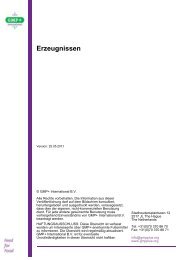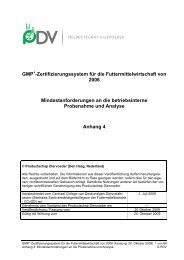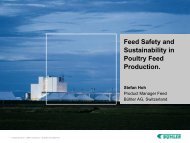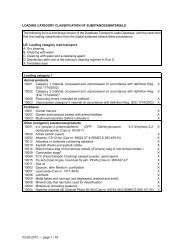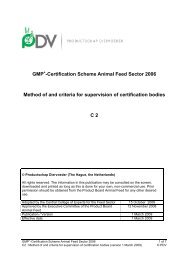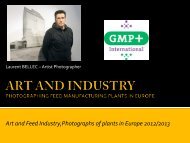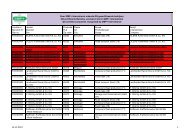Certification Scheme Animal Feed Sector 2006 ... - Gmpplus.org
Certification Scheme Animal Feed Sector 2006 ... - Gmpplus.org
Certification Scheme Animal Feed Sector 2006 ... - Gmpplus.org
You also want an ePaper? Increase the reach of your titles
YUMPU automatically turns print PDFs into web optimized ePapers that Google loves.
1. INTRODUCTION<br />
Requirements are set in various GMP + standards for the transportation of feeds. The aim of<br />
these standards is to control the risks of cross-contamination of animal feeds. Loading<br />
sequence and cleaning and disinfection are major control measures for preventing crosscontamination.<br />
This appendix sets further requirements for this cleaning, disinfection and<br />
loading sequence in the road transport of animal feeds.<br />
The control measures with respect to transport sequence, cleaning and disinfection are the<br />
result of a generic risk assessment for the transport of animal feeds. These control measures<br />
are an implementation of the HACCP principles for the transportation of animal feeds.<br />
2. MINIMUM REQUIREMENTS<br />
2.1 Loading sequence<br />
Prior to the acceptance of a transport commission, the participant should<br />
determine the loading category of the new cargo. The loading categories of the previous loads<br />
should also be determined before loading.<br />
Four main categories of prior loads are distinguished in annex A:<br />
LR1. Very high-risk materials<br />
LR2. Microbiologically contaminated material<br />
LR3. Materials constituting a physical and/or chemical risk<br />
LR4. Neutral materials<br />
A cleaning and disinfection regime has been established for each loading category. Annex A<br />
contains the instructions relating to loading sequence and the cleaning and disinfection regimes.<br />
The participant in GMP + B4.1 should follow these instructions for loading sequence, cleaning<br />
and disinfection.<br />
Use should be made for the classification of products into loading categories of the categories in<br />
the Road Transport Loads Database. Annex B is a shortened version of the database . The<br />
participant uses the categories to determine the loading category for a product. This is done<br />
initially on the basis of the specific name of a product (generic name, not the brand name) or on<br />
the basis of the name of a product group. Products which do not appear in one of the loading<br />
categories LR2, LR3 or LR4 in Annex B are prohibited as loads for means of transport in which<br />
animal feeds are also carried.<br />
The following basic principles apply:<br />
• Before every animal feed transport there must be a visual check that the loading<br />
compartment is clean which means that it is completely empty and free of remains and<br />
odours from previous load and is dry.<br />
• Loads in category LR1 are prohibited for vehicles which transport animal feeds.The carrier<br />
must be able to show that in the past no prohibited loads from loading category LR1 were<br />
transported.<br />
• After the transportation of products in loading category LR2 there should always be cleaning<br />
and disinfection before the first load of animal feeds.<br />
GMP+ <strong>Certification</strong> <strong>Scheme</strong> <strong>Animal</strong> <strong>Feed</strong> <strong>Sector</strong> <strong>2006</strong> 3 of 26<br />
Appendix 14 : Minimum requirements for Road Transport (version 16 November 2007) © PDV



